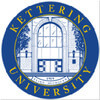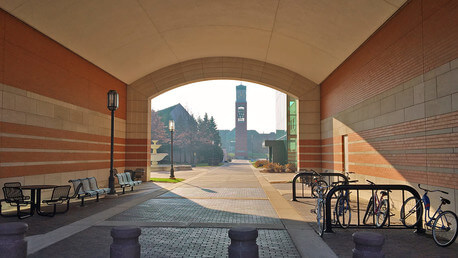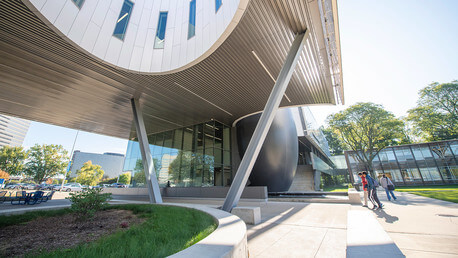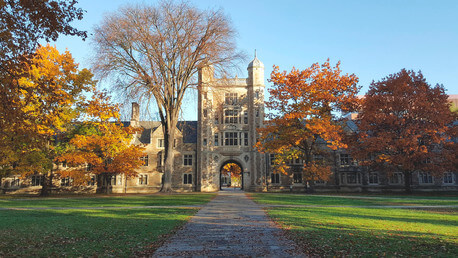Tuition, Cost & Aid
Affordability and Cost
Average Net Price Average net price for full-time, first-time degree/certificate-seeking undergraduates paying the in-state or in-district tuition rate who were awarded grant or scholarship aid from federal, state or local governments, or the institution. Other sources of grant aid are excluded. Aid awarded anytime during the full aid year is included.
Average net price is generated by subtracting the average amount of federal, state or local government, or institutional grant and scholarship aid from the total cost of attendance. Total cost of attendance is the sum of published tuition and required fees (lower of in-district or in-state), books and supplies and the weighted average room and board and other expenses.
Average net price is generated by subtracting the average amount of federal, state or local government, or institutional grant and scholarship aid from the total cost of attendance. Total cost of attendance is the sum of published tuition and required fees (lower of in-district or in-state), books and supplies and the weighted average room and board and other expenses.
$37,518
Average Net Price By Family Income
Tuition
| In-State Tuition In-state tuition is the tuition charged by institutions to those students who meet the state's or institution's residency requirements. In-district tuition is the tuition charged by the institution to those students residing in the locality in which they attend school and may be a lower rate than in-state tuition if offered by the institution. | $43,935 |
| Out-of-State Tuition Out-of-state tuition is the tuition charged by institutions to those students who do not meet the state's or institution's residency requirements. Out-of-district tuition is the tuition charged by the institution to those students not residing in the locality in which they attend school. | $43,935 |
Additional Costs
Room and Board The weighted average for room and board and other expenses is generated as follows:
| $8,930 |
| Books and Supplies | $1,100 |
| Tuition Payment Plan | Yes |
Financial Aid: visit page
Financial Aid Email: [email protected]
Aid & Grants
0
100
87%
Need Met
Students Receiving Gift Aid Percent of undergraduate students awarded federal gift aid. Federal gift aid includes any grant or scholarship aid awarded, from the federal government, a state or local government, the institution, and other sources known by the institution. Students Receiving Grants Percent of undergraduate students awarded grant aid. Grant aid includes any grant or scholarship aid awarded, from the federal government, a state or local government, the institution, and other sources known by the institution. Students receiving state aid Students receiving federal aid
20%
Average Aid Per Year
$23,367
20%
Average Federal Grant Aid Per Year
$5,643
Average Institution Grant Aid Per Year
$20,770
54%
Average State Grant Aid Per Year
$2,708
20%
Average Federal Grant Aid Per Year
$5,643
Average Grant & Scholarship By Family Income
Total Needs Based Scholarships/Grants Total amount of grant or scholarship aid awarded to all undergraduates from the federal government, state/local government, the institution, and other sources known to the institution.
$20,748,958
Total Non-Need-Based Scholarships/Grants
$10,325,694
Student Loans
Students Borrowing Loans Loans to students - Any monies that must be repaid to the lending institution for which the student is the designated borrower. Includes all Title IV subsidized and unsubsidized loans and all institutionally- and privately-sponsored loans. Does not include PLUS and other loans made directly to parents.
55%
Average Loan Amount Per Year
$12,274
Students receiving federal loans
55%
Average Federal Loans Per Year
$5,352
Average Other Loans Per Year
$20,317
Average Debt at Graduation The median federal debt of undergraduate borrowers who graduated. This figure includes only federal loans; it excludes private student loans and Parent PLUS loans.
$26,834
Loan Default Rate
4%
US National: 7%
Median Monthly Loan Payment The median monthly loan payment for student borrowers who completed, if it were repaid over 10 years at a 5.05% interest rate.
$267
What Students Are Saying
It is quite pricey and it isn't easy to find a co-op right now...
Zachary from Defiance, OH
Yeah, it's expensive, but the scholarships are extremely generous and easy to get for good students. Plus, Co-op pays big, so you won't be in too much debt by the time you graduate. There's also a 100% employment rate, so you don't have to worry about this economy impeding your ability to get a job.
Kellie from Cary, IL
Kettering is pretty expensive, but it's totally worth it! The co-op program helps offset the cost and help you prepare for your future! I was able to land a co-op job with NASA at the Kennedy Space Center. Even though I may have some student loans, Kettering helped me get my foot in the door at an amazing Government Agency!
Andy from Mount Morris, MI
Kettering is pretty expensive, but they do give decently sized scholarships to most people.
Luke from Belding, MI
No denying it. Kettering is expensive. But keep your grades up and you're bound to get either a need based or merit based scholarship.
Elysia from Lindenhurst, IL
It's a pretty pricey college, but well worth it. Co-op is a big help with keeping the cost down (once you find a co-op job) and there are plenty of scholarships available, especially if you're a good student.
Jon-Alan from Toledo, OH
Kettering may look pricey, but lots of scholarships are offered and they're easy to get. Combine that with your co-op earnings and you can't go wrong. In addition, you'll be graduating with two years of work experience, which puts you ahead of other graduates who didn't do co-op.
Melissa from Stanton, MI
You will make more than the others do right out of college and pay will only go up.
Co-Op education only helps solidify this
Co-Op education only helps solidify this
Justin from Fenton, MI












